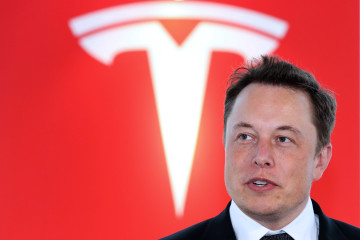Race to the Moon Still On After Google Drops $20 Million Prize

published Mar 11, 2018, 4:00:11 PM, by Pavel Alpeyev
(Bloomberg) —
Google called off its race to the moon weeks ago, when it became clear no private explorer would complete the trip by the March 31 deadline. That won’t stop at least three teams from Israel, Japan and the U.S., who say their missions are a still a go, with or without the contest’s $20 million prize.
“We are full steam ahead,” said Yigal Harel, program director at SpaceIL, the Israeli team that plans a soft-landing on the moon later this year.
When the Lunar XPrize was introduced in 2007, interest in moon exploration was at a low. No government had landed there since the 1970s and no businesses had seriously contemplated it. But the contest has had its intended effect, jump-starting a cottage industry of would-be space explorers, even if no one emerged to take Google’s money. Last year, overall investment in space startups by venture capitalists climbed to a record $2.8 billion, according research firm CB Insights.
One reason the moon is within easier reach is that escaping Earth’s gravity is now so much cheaper. Private launch services like Elon Musk’s Space Exploration Technologies Corp. can put a satellite into orbit for about one-tenth what it would have cost a decade ago. SpaceX last month sent up a rocket powerful enough to lift the weight of a fully-loaded jumbo-jet.
The team most likely to get to the moon first, the non-profit SpaceIL, is attempting the feat mostly to prove it can be done. With some funding from the Israel Space Agency and billionaire casino magnate Sheldon Adelson, they plan to hitch a ride on one of Musk’s Falcon 9 rockets before the end of 2018.
Other teams see business opportunities in building lunar infrastructure, ferrying supplies to the moon or extracting minerals from its soil. If there are vast lakes of ice frozen in the shadows of the moon’s craters, as satellite imagery indicates, that could prove to be a valuable resource. Of course, any commercial enterprise would face the uncertainty of outdated international agreements that don’t address how private property works in space.
Meanwhile, governments are looking at the moon for the first time in years. In the U.S., President Donald Trump requested almost $900 million in new funding for NASA moon missions, which include building a space station in lunar orbit by the mid-2020s. China this year plans to land a probe on the unexplored dark side of the moon, where radio signals from Earth can’t be received.
Carolyn Belle, an analyst at Northern Sky Research, says government space agencies could end up being important customers for commercial moon explorers, especially in the early days when “there isn’t a large potential customer base.”
Pittsburgh-based Astrobotic Technology Inc. and Japan’s ispace inc., two former XPrize competitors, both aspire to be lunar versions of FedEx, with plans to eventually make money by hauling scientific equipment and commercial goods to the moon.
Ispace last year raised more than $90 million from investors including Suzuki Motor Corp. and telecom giant KDDI Corp. The Tokyo-based startup plans to test its delivery vehicle in 2019, by orbiting the moon, and to start landing rovers in 2020.
Its surface vehicle, the Sorato, moves on four wheels studded with paddles, like the water wheels on an old-fashioned steamboat, to claw through the moon’s fine-grained sand. A 360-degree camera mounted on top can capture images almost a million times more detailed than the ones from NASA’s Apollo missions more than 40 years ago.
“What’s going to happen next is a kind of land grab,” said ispace founder and Chief Executive Officer Takeshi Hakamada. “It’s going to be first-come, first-served.”
Rival Astrobotic plans its maiden voyage in 2020. The company, which has partnerships with Caterpillar Inc. and aluminum maker Alcoa Corp., says it will charge about $1.2 million per kilogram ($700,000/pound) to ferry cargo to the moon aboard its Peregrine lander, a four-legged platform about the size of a ping-pong table that can carry a 35-kilogram payload.
So far, Astrobotic says a handful of customers have made down payments on deliveries that include scientific instruments for Mexico’s space agency, a laser communications terminal for beaming high-definition data back to Earth, and a time capsule shaped like a can of Pocari Sweat, a Japanese sports drink.
“What we see is a broad international market for payloads going back to the moon,” said Astrobotic CEO John Thornton. “People are realizing the economic value of space.”
It’s the discovery of water, however, that could really start a gold rush on the moon, according to Rob Chambers, director of human spaceflight strategy at Lockheed Martin Corp.
Breaking free of Earth’s gravity requires so much thrust that fuel accounts for almost 90 percent of the weight in today’s rockets, putting tight limits on how far humans can travel into space. The unforgiving math that engineers use to describe this is known as the Tsiolkovsky Rocket Equation. But water on the moon – and the hydrogen energy locked inside — could offer a way out, by turning Earth’s only natural satellite into a filling station on the way to Mars or beyond.
“What’s the killer app for the moon that’s going to drive its economy?” Chambers said. “I’m putting my money on water.”
To contact the author of this story: Pavel Alpeyev in Tokyo at palpeyev@bloomberg.net To contact the editor responsible for this story: Peter Elstrom at pelstrom@bloomberg.net Jason Clenfield
COPYRIGHT
© 2018 Bloomberg L.P




No Comment